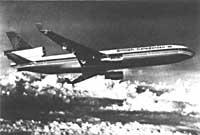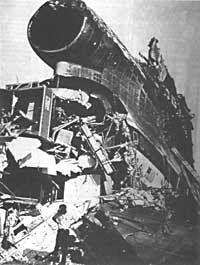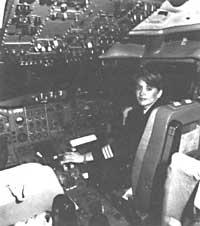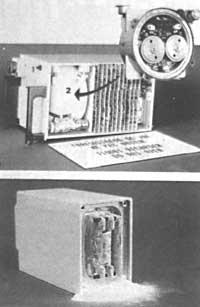Black starter box (or accident illuminator)

With the intention of expressing things as they are, we first say that the black box is not black and is not one. Each plane has two boxes and are orange to facilitate its location after the accident. In addition, these boxes are not analyzed only in case of accident. Suspicion of any breakdown is sufficient to investigate what is recorded within the boxes.
Both boxes are located at the limit of the pressurized space and as close as possible to the tail, since it is the least damaged part in case of accident. The boxes are very robust, able to withstand accelerations 1000 times higher than those of terrestrial gravitation. Temperatures of 1100°C are able to withstand 30 minutes and, in addition, can remain under water more than thirty days without deteriorating.
The information kept inside the boxes is usually the only way to explain the causes of the accident. For this reason, in the manufacture all the factors are taken into account so that after the accidents are complete and easy to find.
However, these orange boxes do not open only after the accident. They open periodically to know the real working conditions of the plane and the technicians have the most precious information to understand the behavior of the plane. In addition, every time the pilot detects something special on the plane, he can request a review of what is registered in the boxes.

The first black box is the simplest. Inside you only have sound recorder. The crew records what was said to the christening, but also conversations with other people, such as pirate aircraft. Four different tracks are used. The first is to register the pilot's communications with the ground control towers. In the second, the pilot records the conversations held with the co-pilot from the intercom of the plane. In the third one there are sounds or environmental noises: crew vests, special noises, threats of hijackers, explosion, strange noises of engines, etc. On the fourth track is collected what was said by the commander or the aircraft servers to the passengers.
These records are made on an endless tape. There are currently three techniques, although in most cases the bulk tape is used. The autonomy of the recording tape is usually half an hour. The black box is always being recorded, but once the tape is finished, the engraving is erased again and the new one is recorded above. Therefore, if an accident occurred, only those of the last half hour would be collected in the black box. The truth is that only half an hour later we have to investigate why the accident has occurred. However, there are sometimes manufacturers who make 8 or 12 tracks recorders.
Another problem that has this first box are the interviews in the cockpit of the pilots. Interviews are not always technical and often have to do with the private life of the crew, so they have nothing to publish. For this reason, the plane commander has the right to erase the band of these private conversations, but for this he has to meet three conditions: having the flight full without problems, having the engines off and being given the parking brake.

The second black box of the plane is more complex. Being its function to record a lot of data, it can receive from 16 to 32 parameters depending on the type of aircraft. This box has a autonomy of twenty-five hours and its operation is different from that of the first. Given that to have a record track of twenty-five hours a very long tape would be necessary, the information that is collected from the captors dispersed in the plane is encoded in numerical values. These values are collected on a single track under the PCM code (Pulse Code Modulation or Modulation Encoded Pulsed) and remain as a numerical magnetophone or a compact disc.
The information so obtained are very different. Some parameters, such as the GMT (Greenwich time) or the one indicating the exit of the landing gear, evolve slowly. Others are fast, vertical accelerations, oil pressures, etc. Due to coding problems, these parameters cannot be recorded all at the same time and this second box works by prioritizing the 4-second cycle. In addition, if necessary, in a four-second cycle a certain parameter is recorded several times. For this purpose, it has a cycle of four seconds divided into four subcycles per second. Each of these subcycles also has 64 binary words and 12 bits (0 or 1).
In most cases, the twelve bits give more precision than what can be obtained with the pickers. With ten bits a sufficient accuracy is obtained, but the other two bits are not wasted: they are used to memorize the position of some switches (for example, if the landing gear is going out or into).
Although the principles of the data logger (second box) and the sound logger (first box) are different, there are few mechanical differences, since the data logger is a 14-track magnetophone that works basically as autoreverse. Only one track (the first), the second, etc., is recorded until the fourteenth. In this way it is possible to record in twenty-five hours without erasing anything.

Despite being very careful when manufacturing, in case of accident it can damage the black box. In this case, you may need a work of months to extract your data. The pieces of tape will be collected and treated in a gel with iron oxide particles, which will be manually decoded.
For this reason, the technicians try to replace the magnetic tape with empty electronic memories, but for this it would be necessary a memory of 70 megabites (70 million basic information), difficult to put in the measures of the black box.
The electronic memory does not have, moreover, mobile pieces and it would be easy to have it filled with a gel. In this way, in case of accident, your condition would be more difficult. On the other hand, the use of magnetic tape causes it to be worn and damaged, and electronic memory does not. It would not be surprising that soon the black boxes replaced the magnetic tapes by computer.
Buletina
Bidali zure helbide elektronikoa eta jaso asteroko buletina zure sarrera-ontzian











